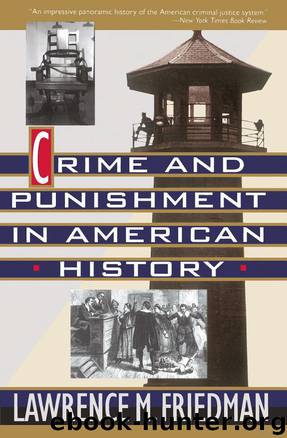Crime and Punishment in American History by Lawrence M. Friedman

Author:Lawrence M. Friedman
Language: eng
Format: mobi, epub
Tags: Law, Nonfiction
ISBN: 9780465024469
Publisher: Basic Books
Published: 1993-01-02T10:00:00+00:00
14
REALIGNMENT AND REFORM
STARTLING CHANGES HAVE TAKEN PLACE IN CRIMINAL JUSTICE IN THE COURSE of the twentieth century. These changes have affected substantive law, procedural law, and the law of corrections. In many ways, however, state penal codes in the 1990s do not look very different from those of 1900. The classic crimes—murder, arson, burglary, and the like—remain much as they were. The growth has been in crimes not listed in the penal codes: economic and regulatory crimes. There has also been some tinkering with this or that definition, of this or that crime, sometimes in significant ways. The law of rape may be one example.
In the twentieth century, procedural rules have been reformed and rationalized. This has happened for rules of criminal procedure as well. Criminal procedure in the federal courts had once had been something of an incoherent mess. The rules had been moving in a piecemeal way toward the ideal: a simple, limpid, transparent system, fair to defendants, efficient, and free from the old, crabbed, hypertrophic rules. In 1940, Congress gave the Supreme Court authority to prescribe “rules of pleading, practice, and procedure” for the federal district courts in the states and territories.1 The Court appointed an advisory committee that met, drafted, wrangled, published preliminary versions, then a final version of rules. The attorney general submitted them to Congress on January 3, 1945, and they went into effect on March 23, 1946. The federal rules have been an important model to the states, which were also intent on cleaning up their procedural systems. Some, indeed, simply swallowed the federal rules as a whole.
Change and reform are themes of every chapter in part III of this book, but this chapter singles out a few topics for special treatment: the “constitutionalization” of criminal justice; punishment and corrections; and the death penalty. In each case, an interesting pattern of development is apparent. There is periodic “reform” throughout the first half of the century, but after World War II the curve shoots up dramatically. A climax comes in the 1950s and 1960s, after which the curve flattens out or actually dips—and this is the situation today. By reform we refer, generally, to changes that emphasize due process, rather than crime control.2 There are considerable differences in detail, from topic to topic, but the pattern is so similar that it obviously reflects gross cultural changes. Later on, we will try to piece together some notions of what these might be.
Download
Crime and Punishment in American History by Lawrence M. Friedman.epub
This site does not store any files on its server. We only index and link to content provided by other sites. Please contact the content providers to delete copyright contents if any and email us, we'll remove relevant links or contents immediately.
| Anthropology | Archaeology |
| Philosophy | Politics & Government |
| Social Sciences | Sociology |
| Women's Studies |
The Secret History by Donna Tartt(18852)
The Social Justice Warrior Handbook by Lisa De Pasquale(12143)
Thirteen Reasons Why by Jay Asher(8800)
This Is How You Lose Her by Junot Diaz(6796)
Weapons of Math Destruction by Cathy O'Neil(6148)
Zero to One by Peter Thiel(5690)
Beartown by Fredrik Backman(5600)
The Myth of the Strong Leader by Archie Brown(5427)
The Fire Next Time by James Baldwin(5250)
How Democracies Die by Steven Levitsky & Daniel Ziblatt(5129)
Promise Me, Dad by Joe Biden(5088)
Stone's Rules by Roger Stone(5027)
A Higher Loyalty: Truth, Lies, and Leadership by James Comey(4846)
100 Deadly Skills by Clint Emerson(4842)
Rise and Kill First by Ronen Bergman(4705)
Secrecy World by Jake Bernstein(4651)
The David Icke Guide to the Global Conspiracy (and how to end it) by David Icke(4628)
The Farm by Tom Rob Smith(4439)
The Doomsday Machine by Daniel Ellsberg(4419)
